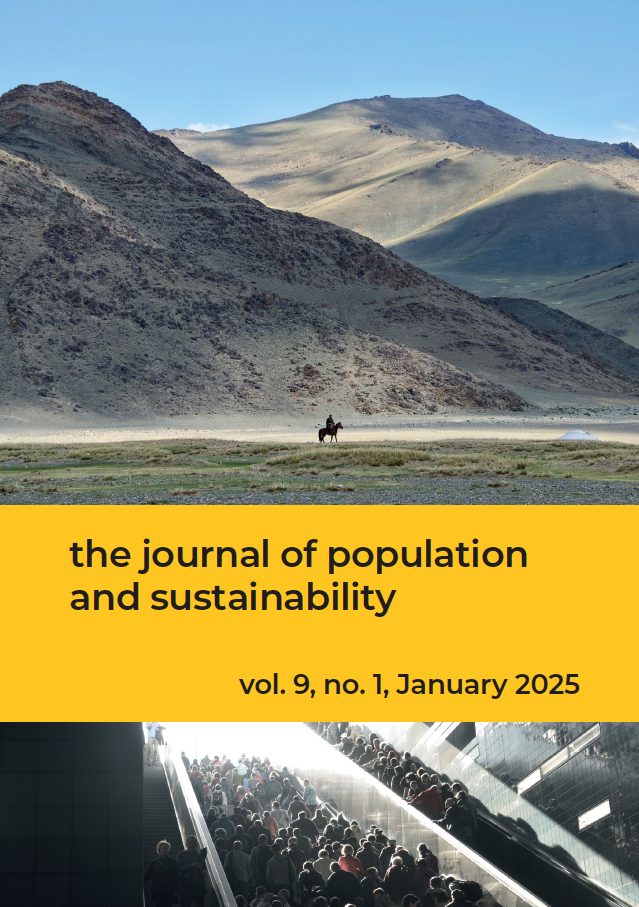Editorial Introduction
Published 2025-01-27
How to Cite
Samways, David. 2025. “Spatial and Temporal Abstraction, Individual Agency and Aggregate Trends in Population Dynamics”. The Journal of Population and Sustainability 9 (1):5-17. https://doi.org/10.3197/JPS.63799977346501.
Copyright (c) 2025 David Samways

This work is licensed under a Creative Commons Attribution 4.0 International License.
Downloads
Download data is not yet available.
References
- Almond, R.E.A., M. Grooten, D. Juffe Bignoli and T. Petersen (eds). 2022. Living Planet Report 2022 – Building a Nature-Positive Society. Gland, Switzerland: WWF.
- Anwar, A.I. and M.Y. Mughal. 2016. ‘Migrant remittances and fertility’. Applied Economics. https://doi.org/10.1080/00036846.2016.1139676
- Attfield, R. 1983. The Ethics of Environmental Concern. Oxford: Blackwell
- Bocquet-Appel, J-P. 2011. ‘When the World’s population took off: The springboard of the Neolithic demographic transition’ Science 333 (6042): 560–61. https://doi.org/10.1126/science.1208880
- Brondízio, E.S., J. Settele, S. Díaz and H.T. Ngo (eds). 2019. Global Assessment Report of the Intergovernmental Science-Policy Platform on Biodiversity and Ecosystem Services. Bonn: IPBES secretariat.
- Cangiano, A. and B. Brindle, B. 2024. The Impact of Migration on UK Population Growth. Oxford: The Migration Observatory. https://migrationobservatory.ox.ac.uk/resources/briefings/the-impact-of-migration-on-uk-population-growth/ (accessed 2 January 2025).
- Cleland, J. and C. Wilson. 1987. ‘Demand theories of the fertility transition: An iconoclastic view’, Population Studies 41 (1): 5–30. https://doi.org/10.1080/0032472031000142516
- Coale, A.J. 1984. ‘The demographic transition’. The Pakistan Development Review XXIII (4).
- Coole, D. 2018. Should We Control World Population? Cambridge: Polity.
- Crist, E. et al. 2021. ‘Protecting half the planet and transforming human systems are complementary goals’. Frontiers in Conservation Science 2: 761292. https://doi.org/10.3389/fcosc.2021.761292
- Davis, J. and D. Lopez-Carr. 2010. ‘The effects of migrant remittances on population– environment dynamics in migrant origin areas: international migration, fertility, and consumption in highland Guatemala’. Population and Environment 32: 216–37. https://doi.org/10.1007/s11111-010-0128-7
- Edwards, T. 2022. ‘Remittance flows and the environmental degradation–migration nexus’. The Journal of Population and Sustainability 6 (2): 31–48. https://doi.org/10.3197/JPS.63788304908975
- Feeney, J. 2019. ‘Hunter-gatherer land management in the human break from ecological sustainability’. Anthropocene Review 6 (3): 223–42. https://doi.org/10.1177/2053019619864382
- Giddens, A., 1979. Central Problems in Social Theory. Basingstoke: Macmillan
- Giddens, A., 1984. The Constitution of Society. Cambridge: Polity Press.
- Green, S.H., C. Wang, S.S. Ballakrishnen, H. Brueckner and P. Bearmand. 2019. ‘Patterned remittances enhance women’s health-related autonomy’. SSM Population Health 9: 100370. https://doi.org/10.1016/j.ssmph.2019.100370
- Hecht, S.B., S. Kandel, I. Gomes, N. Cuellar and H. Rosa. 2006. ‘Globalization, forest resurgence, and environmental politics in El Salvador’. World Development 34 (2): 308–23. https://doi.org/10.1016/j.worlddev.2005.09.005
- Ifelunini, I.A., S.C. Ugwu, H.E. Ichoku, A.N. Omeje and E. Ihim. 2018. ‘Determinants of fertility rate among women in Ghana and Nigeria: Implications for population growth and sustainable development’. African Population Studies 32 (2)(S.2).
- Intergovernmental Panel on Climate Change (IPCC). 2023. Climate Change 2022 – Impacts, Adaptation and Vulnerability: Working Group II Contribution to the Sixth Assessment Report of the Intergovernmental Panel on Climate Change. Cambridge: Cambridge University Press. https://doi.org/10.1017/9781009325844
- Jaquet, S., G. Shrestha, T. Kohler and G. Schwilch. 2016. ‘The effects of migration on livelihoods, land management, and vulnerability to natural disasters in the Harpan Watershed in Western Nepal’. Mountain Research and Development 36 (4): 494–505. https://doi.org/10.1659/MRD-JOURNAL-D-16-00034.1
- Mbow, C., C. Rosenzweig, L.G. Barioni, T.G. Benton, M. Herrero, M. Krishnapillai, E. Liwenga, P. Pradhan, M.G.Rivera-Ferre, T. Sapkota, F.N. Tubiello and Y. Xu. 2019: ‘Food Security’. In P.R. Shukla et al. (eds), Climate Change and Land: an IPCC special report on climate change, desertification, land degradation, sustainable land management, food security, and greenhouse gas fluxes in terrestrial ecosystems. https://doi.org/10.1017/9781009157988.007
- Monbiot, G. 2020. ‘Population panic lets rich people off the hook for the climate crisis they are fuelling’. The Guardian: https://www.theguardian.com/commentisfree/2020/aug/26/panic-overpopulation-climate-crisis-consumption-environment (accessed August 2024).
- Nunn, N. and N. Qian. 2010. ‘The Columbian Exchange: A history of disease, food, and ideas’. Journal of Economic Perspectives 24 (2): 163–88. https://doi.org/10.1257/jep.24.2.163
- O’Neill, B., B. Liddle, L. Jiang, K.R. Smith, S. Pachauri, M. Dalton and R. Fuchs. 2012. ‘Demographic change and carbon dioxide emissions’. The Lancet 380: 157–64. http://dx.doi.org/10.1016/S0140-6736(12)60958-1
- O’Neill, D.W., A.L. Fanning, W.F. Lamb and J.K. Steinberger. 2018. ‘A good life for all within planetary boundaries’. Nature Sustainability 1: 88–95. https://doi.org/10.1038/s41893-018-0021-4
- O’Sullivan, J.N. 2023. ‘Demographic delusions: World population growth is exceeding most projections and jeopardising scenarios for sustainable futures’. World 4: 545–68. https://doi.org/10.3390/world4030034
- Page A.E. and J.C. French. 2020; ‘Reconstructing prehistoric demography: What role for extant hunter-gatherers?’ Evolutionary Anthropology 29: 332–45. https://doi.org/10.1002/evan.21869
- Paul, F.H., G.H. Talpur, R. Soomro and A.A Marri. 2019. ‘The impact of remittances on fertility rate: Evidence from Pakistan.’ Sindh University Research Journal (Science Series). 51 (01): 129–34. http://doi.org/10.26692/sujo/2019.01.23
- Pozzi, L. and D. Fariñas. 2015. ‘Infant and child mortality in the past’. Annales de démographie historique 129 (1): 55–75. https://doi.org/10.3917/adh.129.0055
- Samways, D. 2021. ‘Population and our contemporary ecological crisis’. In C. Nellist (ed.), Climate Crisis and Creation Care: Historical Perspectives, Ecological Integrity and Justice, pp. 286–307. Newcastle upon Tyne: Cambridge Scholars Publishing.
- Samways, D. 2022. ‘Population and sustainability: Reviewing the relationship between population growth and environmental change’. The Journal of Population and Sustainability 6 (1): 15–41. https://doi.org/10.3197/JPS.63772239426891
- Stones, R. 2005. Structuration Theory. Basingstoke: Palgrave Macmillan
- United States Census Bureau, 2024. Net international migration drives highest U.S. population growth in decades: https://www.census.gov/newsroom/press-releases/2024/population-estimates-international-migration.html (accessed 2 January 2025).
- Wilson, C. and P. Airey. 1999. ‘How can a homeostatic perspective enhance demographic transition theory?’ Population Studies 53 (2): 117–28. https://doi.org/10.1080/00324720308076





